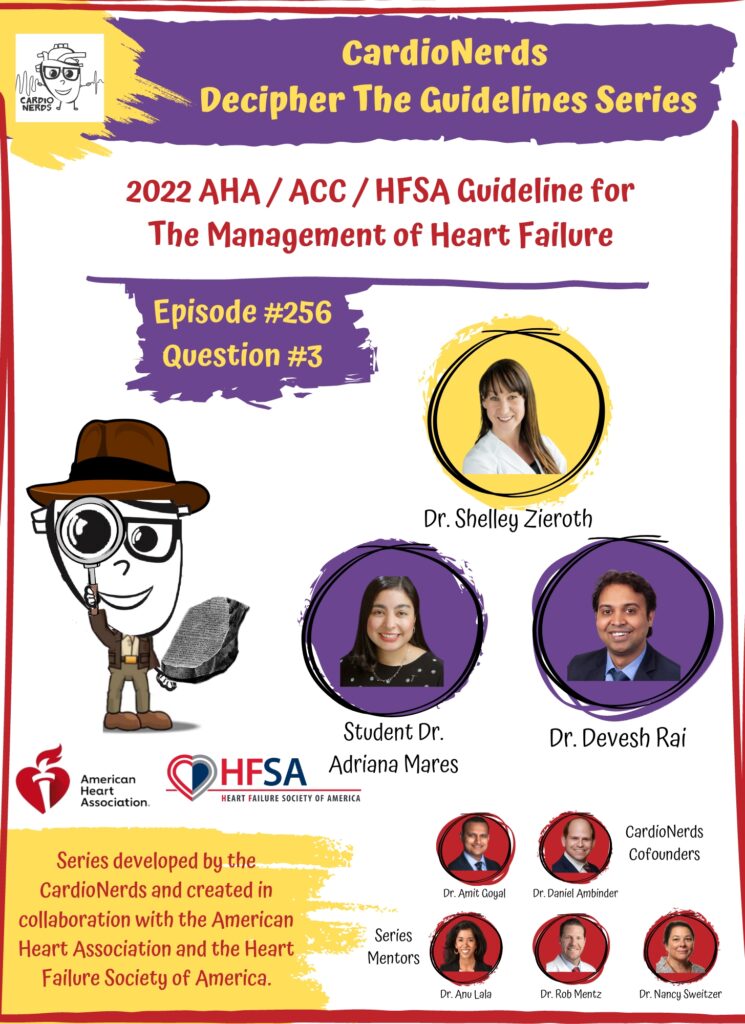Cardionerds: A Cardiology Podcast

256. Guidelines: 2022 AHA/ACC/HFSA Guideline for the Management of Heart Failure – Question #3 with Dr. Shelley Zieroth
The following question refers to Section 3.1 of the 2022 AHA/ACC/HFSA Guideline for the Management of Heart Failure. The question is asked by Texas Tech University medical student and CardioNerds Academy Intern Dr. Adriana Mares, answered first by Rochester General Hospital cardiology fellow and Director of CardioNerds Journal Club Dr. Devesh Rai, and then by expert faculty Dr. Shelley Zieroth.
Dr. Zieroth is an advanced heart failure and transplant cardiologist, Head of the Medical Heart Failure Program, the Winnipeg Regional Health Authority Cardiac Sciences Program, and an Associate Professor in the Section of Cardiology at the University of Manitoba. Dr. Zieroth is a past president of the Canadian Heart Failure Society. She is a steering committee member for PARAGLIE-HF and a PI Mentor for the CardioNerds Clinical Trials Program.
The Decipher the Guidelines: 2022 AHA / ACC / HFSA Guideline for The Management of Heart Failure series was developed by the CardioNerds and created in collaboration with the American Heart Association and the Heart Failure Society of America. It was created by 30 trainees spanning college through advanced fellowship under the leadership of CardioNerds Cofounders Dr. Amit Goyal and Dr. Dan Ambinder, with mentorship from Dr. Anu Lala, Dr. Robert Mentz, and Dr. Nancy Sweitzer. We thank Dr. Judy Bezanson and Dr. Elliott Antman for tremendous guidance.
Which of the following is/are true about heart failure epidemiology?
A
Although the absolute number of patients with HF has partly grown, the incidence of HF has decreased
B
Non-Hispanic Black patients have the highest death rate per capita resulting from HF
C
In patients with established HF, non-Hispanic Black patients have a higher HF hospitalization rate compared with non-Hispanic White patients
D
In patients with established HF, non-Hispanic Black patients have a lower death rate compared with non-Hispanic White patients
E
All of the above
Explanation
The correct answer is “E – all of the above.”
Although the absolute number of patients with HF has partly grown as a result of the increasing number of older adults, the incidence of HF has decreased. There is decreasing incidence of HFrEF and increasing incidence of HFpEF. The health and socioeconomic burden of HF is growing. Beginning in 2012, the age-adjusted death-rate per capita for HF increased for the first time in the US. HF hospitalizations have also been increasing in the US. In 2017, there were 1.2 million HF hospitalizations in the US among 924,000 patients with HF, a 26% increase compared with 2013.
Non-Hispanic Black patients have the highest death rate per capita. A report examining the US population found the age-adjusted mortality rate for HF to be 92 per 100,000 individuals for non-Hispanic Black patients, 87 per 100,000 for non-Hispanic White patients, and 53 per 100,000 for Hispanic patients.
Among patients with established HF, non-Hispanic Black patients experienced a higher rate of HF hospitalization and a lower rate of death than non-Hispanic White patients with HF.Hispanic patients with HF have been found to have similar or higher HF hospitalization rates and similar or lower mortality rates compared with non-Hispanic White patients.
Asian/Pacific Islander patients with HF have had a similar rate of hospitalization as non-Hispanic White patients but a lower death rate.
These racial and ethnic disparities warrant studies and health policy changes to address health inequity.
Main Takeaway
Racial and ethnic disparities in death resulting from HF persist, with non-Hispanic Black patients having the highest death rate per capita, and a higher rate of HF hospitalization. Further clinical studies and health policy changes are needed to address these inequalities.
Guideline Loc.
Section 3.1
Decipher the Guidelines: 2022 Heart Failure Guidelines Page
CardioNerds Episode Page
CardioNerds Academy
Cardionerds Healy Honor Roll
CardioNerds Journal Club
Subscribe to The Heartbeat Newsletter!
Check out CardioNerds SWAG!
Become a CardioNerds Patron!







 Visit Podcast Website
Visit Podcast Website RSS Podcast Feed
RSS Podcast Feed Subscribe
Subscribe
 Add to MyCast
Add to MyCast